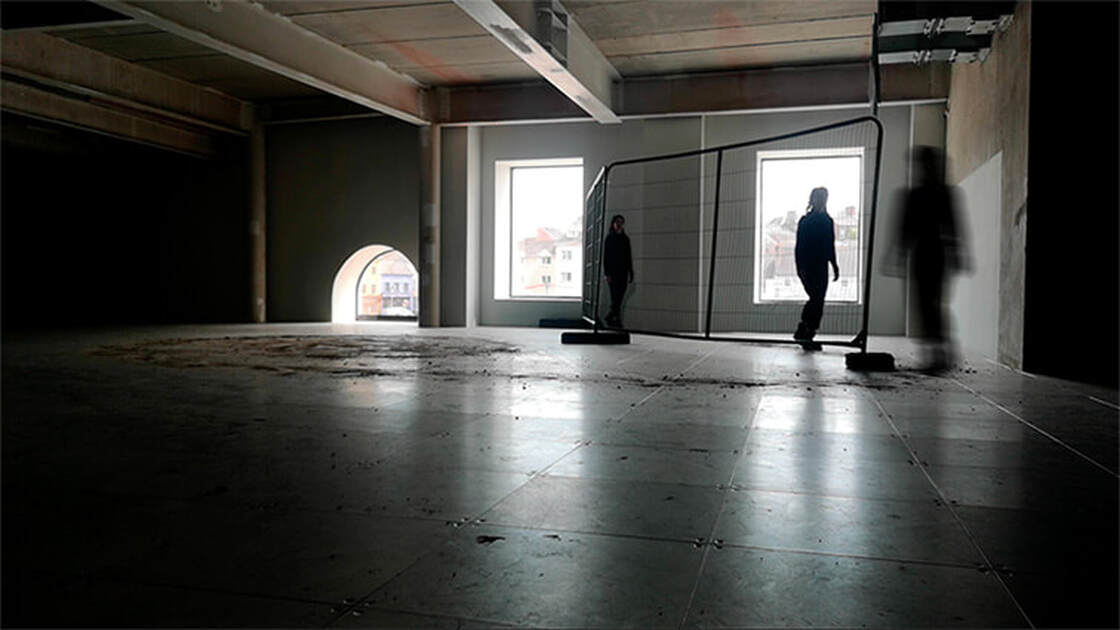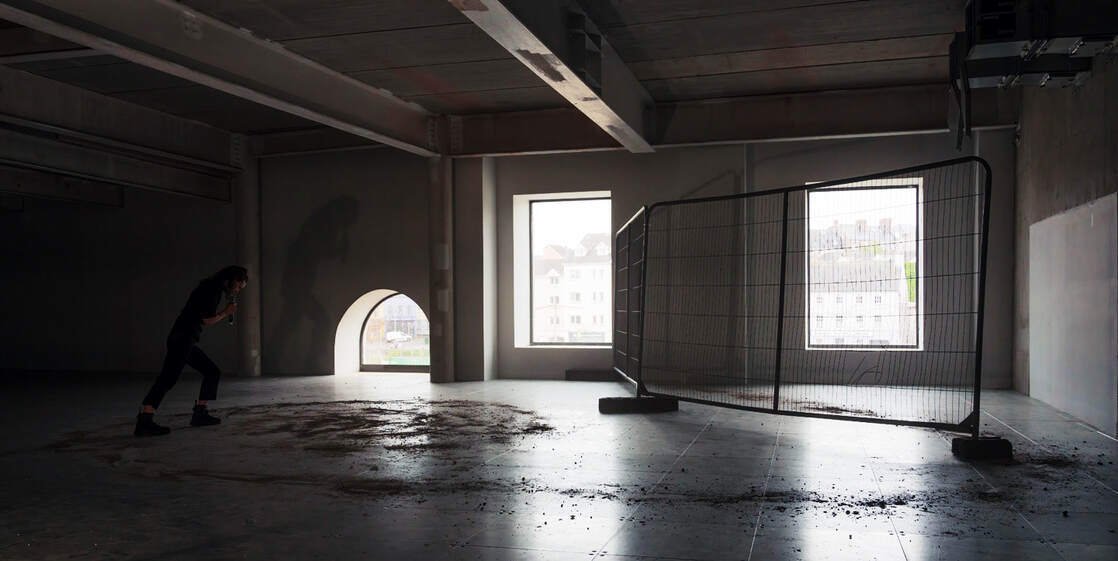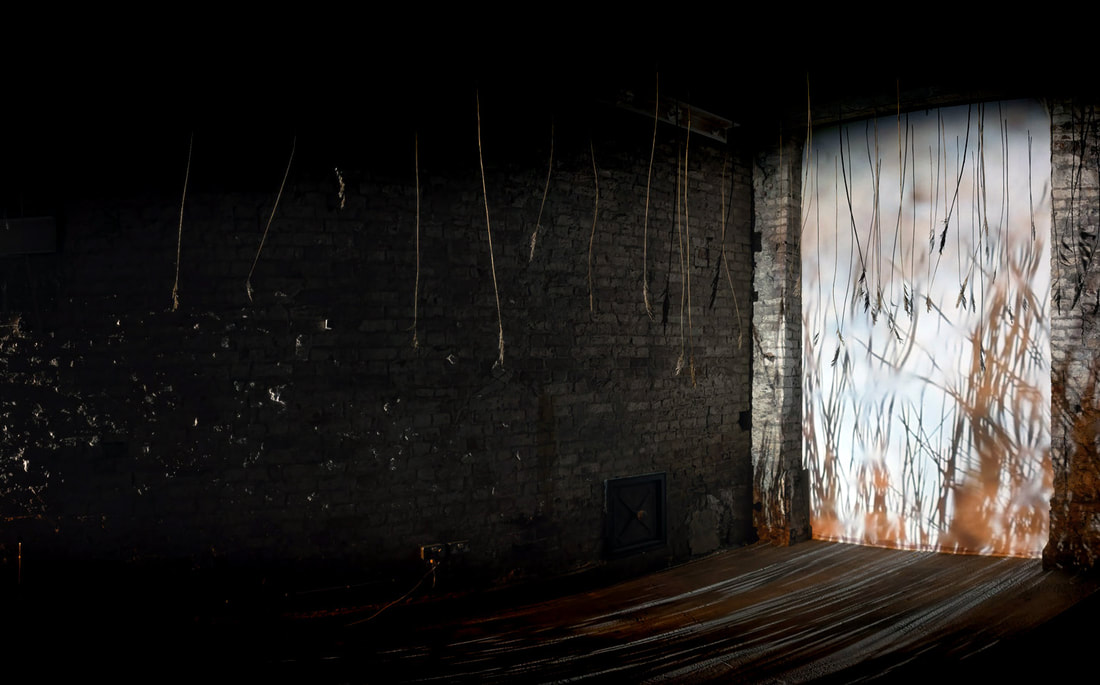C E A S E L E S S , M O R E
Spoken word performance and installation
Spoken word performance and installation
Ceaseless, more spoken word performance explores a breathlessness of humanity by the hand of capitalism, and the drive towards perpetual progress. A sense of accelerating constriction undergirds the performance. It weaves social and political contexts and its effects on the corporeal and takes a critical stance on our current reality. Using materials from the adjacent construction site viewed from the window, Kate links the inner and outer environments.
C A S C A D I N G , H I G H
Layered 35mm photographic prints on vegetal paper
Layered 35mm photographic prints on vegetal paper
Cascading, high is a photographic installation documenting the financial districts and developing docklands in cities such as Lisbon, London, Dublin and Cork. It examines the financialization and homogenization of space. Capturing the phantasmagorical effects of these glass and steel structures it echoes the illusionary and disorientating sense of living within the structures of neoliberalism.
O N U N S O L I D G R O U N D
Suspended reeds, video projection, sound
Suspended reeds, video projection, sound
On Unsolid Ground draws from architectural research on the particular street which the exhibition was being held South Main Street which referenced the streets previous state as an area of reed beds. This work reimagines Cork City in its previous form as a marshland, pre reclamation and development, meandered by the river Lee. Through coalescing fragments of time and space, Kate questions our positioning in an interlinked, transforming ecology.
Oscillation: An Altering Rhythm
inter_site at the Counting House, South Main Street, Cork City
19 - 21, May 2023
Extract
Oscillation: An altering rhythm
inter_site at the Counting House
by Pádraig Spillane
I’m writing about inter_site’s takeover of the Counting House from their invitation via Kate. Kate found out I was reading Berardi again. It is a book I had not read before, 2018’s Breathing: Chaos and Poetry[1]. This text was significant for activating their collective occupation of this recently restored and transformed site. As a piece of writing, it allowed them through ways to think about their use of location in preparation for installation and the ripples that come after staging their works. For me, it allowed vantage points to look back on experiencing their works with the push and pull of contemporary currents.
In Breathing, Berardi explores the possibilities of what he calls excess, something extra that comes through poetic and semiotic play. In this shared divided time of scarcity and overabundance, this surplus for Berardi is something not easily overwhelmed by financial speculation. It is and can be turned toward opening up affective moments and events that can offer glimpses (and hopeful ways) for alternative futures. For Berardi, this excess can allow a moving away from conventionally determined implications, procedures, and programmes for life. It is intangible, maybe an affect, a feeling or an attitude, maybe the finding of something in the previously unnoticed.[2] This residual overflow offers release from the circles of commercial influences and their aftereffects. From within such a poetic surplus something else may come to be experienced.
The Counting House on South Main Street lies on the “historic spine” of Cork city. This spine is a line of merging streets from Barrack Street to Shandon Street. It comes from the medieval settling of Cork, linking north to south, from one side of the river to the other. It is historically collaged by its own reconstructions and its location within the city. It is a place of melding legacies including settlement, alcohol brewing, trade, offices, and colonialism. The building’s contemporary architecture is adjacent to heritage conservation with the addition of Miesian clean lines touching a preserved mock Tudor façade of rural nostalgia.[3] It is currently in a latent phase of a hulk-like overhaul ready to be occupied by 21st century office fixtures. Its new fit out of stairways, lifts, and metal alloy floor tiles are waiting to be covered with administrative furnishings, to be inhabited by forces of capital and conversion. It is to be joined by a deferred concert and convention centre, another blocklike extension to the now standing glass cube. Delayed though politics and capital manoeuvres, this place offers its vast interior as a way of negotiating this present time.
inter_site’s installation created a rupturing and dissolving of this space and its temporalities. The presence of these works cleave out excess by working with the material remnants of consumer culture and the infrastructure of late capitalism (or whatever this is now) in this space not yet taken by contactless credit card transactions, office politics, and monetised crowds. Before all this happens, their temporary annexation asks for focus and attention, looking for new meanings to emerge.
...
Images of financial skyscrapers appear in collaged sequences of angles in Kate’s work Cascading, high. These high key image arrangements are suspended on paper light material, standing opaquely, taking their position with newly constructed city vistas seen through the renovated windows of the building. This mix of light and confrontation - of what urban space has become – blends with the new red brick and plastic clad façades of expensive student accommodation buildings just outside. This housing mingles with the tilts and inclines of the work’s ashen appearance of financial centres from different European cities. As an installation, it tends to the recognisable homogenisation and extractive forces on landsites, where money is both accrued and digitally transferred through. This site responsiveness highlights the ways capital has intruded and infiltrated shared common spaces. How the tethering of techno capital-operations to locations has created spaces for its own machinations, its own physical points for increasements where prosperousness is to be pulled out of sight behind encoded city frontages. However, within the semi darkness there is a remove to interiority though this work’s positioning. These commercial clean lines are brought in to relief and yet kept at a distance; a strategy of observing and of thinking through a next move against the continuing financialization of the world.
. . .
In their collective approaches to site[7] and their ways of working individually on related matters, inter_site work with conceptual leanings in how to understand this contemporary time. Their works are permeated with a resistance and energy to think through and share with those who come to experience their installations. The considered use of cultural and consumer remainders with moments of spectacle heightens the viewer’s experience through site responsive strategies. Such events are looking for the dissonant through a performativity of spaces, exploring what it means to live in both an ending and a beginning that cannot be evaded and must be faced.
In this way, the shadowy atmosphere of the Counting House installation takes notice of new orientations and vectors within the world, ones of a letting go or even an overcoming of this world. As Andrew Culp states in his Dark Deleuze[8],perhaps by destroying this world of connected capital power that ravages imaginaries and the planetary, there might come a new world with better ways and descriptions to deal with current issues. inter_site’s work allows such imaginative interference for a renewal of looking to futures. Through conjuring remainders, poetic works, and contrivances with vision technologies, they allow a further way of recognising the structures that hold influence, with potential for untangling their hold. These workings chime with Berardi’s idea of excess as “the condition of revelation, of emancipation from established meaning and of the disclosure of an unseen horizon of signification: the possible.”[9] The given of this contemporary world made of signs, symbols, products, and the networks of financial structures was once created. It is not to be seen at the only or mandatory. Its construction shows that things can be done differently. In this sense, inter_site at the Counting House was a claiming of territory through excess with spectacle and material play. In this suspended space, this installation’s compulsion was an exploration of objects and signals of the contemporary, where new cracks were allowed to come through.
Pádraig Spillane is an artist, educator and freelance curator based in Cork city, Ireland.
[1] Franco “Bifo” Berardi, Breathing: Chaos and Poetry, (USA: Semiotext(e), 2018)
[2] This excess may seem guileless. However, this idea of something extra that can be used to get out of the status quo keeps bubbling through. Ideas like Mark Fisher’s post-capitalist desire and recently Lola Olufemi’s Experiments in Imagining Otherwise keep this move toward reinventing the world in a different way alive. In this regard, Berardi also mentions Félix Guattari’s Chaosmosis: An Ethico-Aesthetic Paradigm in chapter 2 of Breathing entitled Voice Sound Noise, where chaosmosis means a breathing with chaos to bring forth something new. This is also present in Kate’s performance Ceaseless, more in the Counting House.
[3] Big gratitude to Orla McKeever for clarification on this.
[4] Paul Hegarty, Annihilating Noise, (USA: Bloomsbury Academic, 2021), 232
[5] Thinking here of John Carpenter’s 1980 film The Fog and others that allow fog, or something like it, carry some unseen force within it.
[6] The anticipation of being in clubs or raves can be both exhilarating and also cause anxiousness.
[7] inter_site’s Deirdre Breen’s design of this publication-as-site comes under this also.
[8] Andrew Culp, Dark Deleuze, (USA: University of Minnesota Press, 2016), 66
[9] Franco “Bifo” Berardi, Breathing: Chaos and Poetry, (USA: Semiotext(e), 2018), 20



